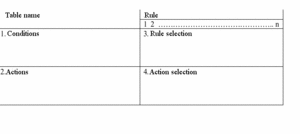Decision table
From CEOpedia | Management online
| Decision table |
|---|
| See also |
Decision tables are one of the basic techniques used in solving problems and decision making. Using decision table one can in a concise way specify, under predetermined conditions, what actions should be taken. Decision table is a specific way of describing a set of related decision rules.
Structure of decision table
Each table is divided into four main fields (S. Wrycza 1996, s. 120-121):
- Conditions - formulation of the necessary conditions in the process of deciding, the definition of variables affecting the decision process,
- Actions - decisions, listing all the possible actions that can be executed on the assumption that specific combination of conditions contained in the first field of the array occurred,
- Selection criteria - there are presented all the states of individual conditions, indicators, values, Symbol placed in this field indicates whether the condition has been fulfilled or not (usually used symbols: "1" condition fulfilled, "0" condition is not met, "-" the condition is not significant).
- Action selection - contains symbols identifying that particular action should be performed (used symbols "X" - action should be taken, "-" actions should not be taken)
Advantages and disadvantages
Advantages of decision tables:
- They provide a clear and concise way to represent decision rules and conditions.
- They make it easy to identify and understand the relationships between conditions and actions.
- They can handle complex decision-making scenarios with multiple conditions and actions.
- They can be used to test different scenarios and evaluate the outcomes of different decisions.
Disadvantages of decision tables:
- They can become complex and difficult to read and understand for large and complex decision-making scenarios.
- They may require significant effort to set up and maintain.
- They may not be suitable for all types of decision-making scenarios, such as those that involve continuous variables or probabilistic outcomes.
- They may not be able to fully capture the nuances of human decision-making and may not be able to replicate the reasoning process.
References
- Wang, G. Y., Yu, H., & Yang, D. C. (2002). Decision table reduction based on conditional information entropy. CHINESE JOURNAL OF COMPUTERS-CHINESE EDITION-, 25(7), 759-766.
Author: Krzysztof Wozniak

